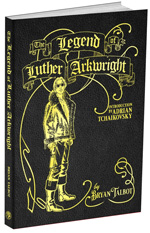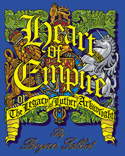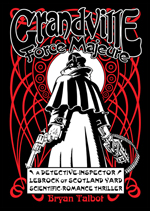It's all in the mind, you know
(Bryan's introduction to the reprinted edition of the Brainstorm comic)
How embarrassing.
Illustrators can always see the worst in their own work produced only a few months ago, never mind twenty five years. Is it really that long? Tempus fugit. Time flies like an arrow. Fruit flies like bananas. Jeez. I'm rambling already and I've only just started. I look back through a purple haze...
I think of this first published work as my apprenticeship in the comics medium and freely admit that I made all my mistakes in print. See, I'm self-taught. That is to say, I was taught by a very ignorant person indeed. Of course I had the same acquired knowledge of comics grammar as anybody who'd spent their life reading them but, as for the actual drawing, I'm a slow learner. Some artists seem to arrive fully-formed. I'm still learning.
At college, I did a graphic design course; the wrong choice. If I'd known I'd end up drawing comics for a living I'd have done illustration. As it was, I was taught typography and layout (which, to be fair, has fed into my storytelling) but I should have been exposed to life drawing, perspective, chiaroscuro et al, all of which I had to learn from practise and library books after I finished the course.
Also, the more I understood about it, the more I grew to dread the world for which I was being trained to work. I just couldn't envisage for myself a life that revolved around advertising junk that I couldn't care less about. I retreated into comics.
This was the golden age of underground comics, the comics of the counterculture, when all the staid barriers confining the medium were being ripped apart. The innocuous comic book was being redefined as a powerful instrument for communication. These new comics could not be pigeonholed; they were experimental and as diverse as the people who wrote and drew them. They were both iconoclastic and retro. They could be as whimsical and surreal as Moscoso and Rick Griffin, or as socially aware and gut-wrenchingly gritty as Tom Veitch and Greg Irons, whose Vietnam strips were literally years ahead of their equivalents in other, more respectable media. They could be as sexist as Crumb or S. Clay Wilson or as feminist as Trina Robbins, as knowingly shocking as Robert Williams or as poignant as Justin Green, as grim as Slow Death or as funny as Gilbert Shelton.
The illustration styles and storytelling techniques were equally diverse and groundbreaking as the medium was pushed to its limit. Panels overlapped in new and ingenious ways and multiple images and audacious metapanels were used for specific effect. Drawing styles from other art forms, such as book illustration or poster design were introduced. Influences from avant-garde literature and art movies were incorporated, resulting in non-linear plots and astonishing pictorial compositions. In time, this was all assimilated into mainstream comics and had a profound effect on the medium as a whole.
There was the usual percentage of bad stuff you get in any medium - naive, poorly executed or irredeemably self-indulgent (which makes it sound like most modern Fine Art) - but this definitely was an exciting time in comics.
"If you ever do a comic, I'll publish it". This was the rash offer made to me by Lee Harris in 1973. I'd met Lee in his shop (Alchemy in Portobello Road. It's still there - go and see) and was in London to submit a strip to Cozmic Comics. The strip was accepted, but they never used it, never paid me and I never saw the artwork again. Publisher Felix Denis, one of the "Oz three", went on to produce poster mags and become a millionaire with a vast publishing empire. A thinly veiled skit of him is in the strip Komix Comics.
Lee is wonderful man, passionate about his beliefs and interests and with an amazing history. From being one of the first white members of the ANC in South Africa, through his years as a playwright and actor, to his publishing of Home Grown magazine and his battles with the law he is, in his own words, "a foot soldier of the counterculture". I keep pestering him to write his autobiography. It'll be fascinating.
Two years after Lee's offer of publication I'd reached a complete dead end. I'd finished college and been unemployed for a year. Mary, our young sons Robin and Alwyn and I were living on the breadline. Instead of doing something sensible, such as getting a job as a dustman (don't laugh; I did apply for it) I decided to do the comic for Lee.
I'd already done about four pages of Out of the Crucible whilst at college, two of which I redrew. The other sixteen pages took me five months. I hitched down to London from Preston, Lancashire and presented it to Lee. True to his word, he published them and told me to get on with the next one. It was the start of my career in comics.
I plucked the title Brainstorm from the section on insanity in Roget's Thesaurus. It just sounded right. There was a track of the same name by Hawkwind (who advertised in the first issue) and it also put me in mind of the Professor Branestawm illustrations by Heath Robinson.
By 1975, the psychedelic adventure story was already an established underground genre. Creators such as Sheridan and Schreiber had laid the groundwork, charting the exploits of their madcap psychonauts in the infinite possibilities of inner space, and were a big influence on Crucible. The tradition goes back further, though, to Alice in Wonderland and Pilgrim's Progress and probably beyond, depending upon how you interpret myth and folklore.
Swiping names from my good mate Chester West and Groucho Marx's Dr. Hackenbush from A Day at the Races, I had my first protagonist. I never stopped to consider characterisation; his reactions were basically my own. One of the hardest things to do when first drawing a comic is to ensure characters are easily identifiable from different angles and from a distance, hence the beard, straight nose and glasses.
My favourite Chester story is From Here to Infinity. The first story was little more than a picture book for trippers, but the second was a lot more considered. I'd been studying classic book illustrators, such as Arthur Rackham, and was trying to produce a synthesis of their styles and American underground styles. The theme is duality and the story inspired by Alice. Like Through the Looking Glass, it can be played through as a chess game, moves and pieces indicated by visual clues. It's also a self-referential adventure story; the various characters and plot devices pointed out to the readers as they happen. Yes, I was trying to be a smart-ass.
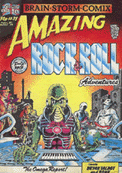 Chester has never really gone away. Apart from his appearances in The Omega Report and the later Smokey Bears shorts and his parallel self, Parsifal, in The Adventures
of Luther Arkwright and the recent Heart
of Empire, he seems to have assumed an independent existence.
Brainstorm was read by many of today's "Brit Pack" writers, such
as Alan Moore, Grant Morrison and Neil Gaiman. There are influences from
Brainstorm in Animal Man and Shade, the Changing Man.
Chester was "Americanised" into Chester Williams in Swamp Thing
and he and other Brainstorm characters have cameos in Bob Walker's
Hawklords graphic novel Ledge of Darkness, The Bush Telegraph
and Ben Hunt's Vogarth. And here he is again in this new reprint.
Chester has never really gone away. Apart from his appearances in The Omega Report and the later Smokey Bears shorts and his parallel self, Parsifal, in The Adventures
of Luther Arkwright and the recent Heart
of Empire, he seems to have assumed an independent existence.
Brainstorm was read by many of today's "Brit Pack" writers, such
as Alan Moore, Grant Morrison and Neil Gaiman. There are influences from
Brainstorm in Animal Man and Shade, the Changing Man.
Chester was "Americanised" into Chester Williams in Swamp Thing
and he and other Brainstorm characters have cameos in Bob Walker's
Hawklords graphic novel Ledge of Darkness, The Bush Telegraph
and Ben Hunt's Vogarth. And here he is again in this new reprint.
He's also in The Tribe - a strip I really didn't want to include but was insisted upon after Mal Burns spent many long hours at the computer, painstakingly retouching this lost strip from an ancient photocopy that had faded to a barely perceptible pale grey. I first met Mal while he was working for CARO - the Cannabis Action Reform Organisation - for whom I'd designed a tee-shirt. He had an unbounded enthusiasm for and an encyclopaedic knowledge of underground comics. I quickly introduced him to Lee, who brought him on board as editor. Later Mal was instrumental in getting Luther Arkwright to a wider audience in Serge Boissevain's PSSST!. One of the great pleasures of working on this collection has been the renewal of my friendship with Mal and Lee. The Tribe was produced for one of the 1970's incarnations of the alternative newspaper International Times that never got off the ground because the would-be publishers were so stupifyingly stoned that they never managed to get it together (and lost the artwork to boot). It was meant to be the first episode of an ongoing underground soap opera of which I'd plotted the first year's storyline. I later used the group of characters as the basis for the Smokey Bears shorts, intended to be a sort of British Fabulous Furry Freak Brothers, for Lee's Home Grown magazine.
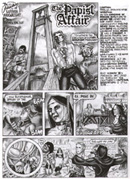 The Papist Affair
was an excuse to do a "ground-level" strip in line and water-colour wash
and was directly inspired by the Jerry Cornelius stories of Michael
Moorcock. After this, Arkwright took on his own personality and I
developed his own milieu , but this was his very first appearance. Now,
just having finished the new Arkwright graphic novel, Heart
of Empire, I realise that he, like Chester, will never be far
from my side.
The Papist Affair
was an excuse to do a "ground-level" strip in line and water-colour wash
and was directly inspired by the Jerry Cornelius stories of Michael
Moorcock. After this, Arkwright took on his own personality and I
developed his own milieu , but this was his very first appearance. Now,
just having finished the new Arkwright graphic novel, Heart
of Empire, I realise that he, like Chester, will never be far
from my side.
I'm still very pleased with the concept and plot of The Omega Report which was produced years before several comparable comic strips and films. The artwork, though, is another thing. Interesting would perhaps be a kind word for it. All the Chester stories were drawn using Rotring technical pens. For this story, I tried to simulate the feel of fifties black and white private dick movies by inking heavily with a brush and using lots of mechanical tints in attempt to create a film noir atmosphere. I'd never inked with a brush before and it took me three months to realise that it was supposed to go to a fine pinpoint at the end. In case this was published "before your time", I have to point out that the whole story is littered with references to 70's rock music.
A few years ago I was at a large media event at Olympia, part of which was an attempt to interest the general public in the comic medium. I was spreading the word to one of the punters, a large, respectable-looking business gent, when he suddenly discovered that I was the guy who used to do Brainstorm. He whooped loudly and snatched me up in a huge bear hug, exclaiming "I loved those comics! Thank you! Thank you!" And this wasn't an isolated incident. There are people who still treasure the comic (usually through some fond acid memory) and think it's the best thing I've ever done. Perhaps they're right. It's all subjective, isn't it?
Perhaps no reason then, to be embarrassed.
'Scuse me while I kiss the sky.
Bryan Talbot
Brainstorm Studios
Also check out Roger Sabin's introduction to the reprinted edition of Brainstorm, and also take a look at the publicity shot of Bryan from 1982 taken at the Alchemy shop, when he was launching the first Arkwright graphic novel: this image will be included in the reprinted edtion of Brainstrom.




